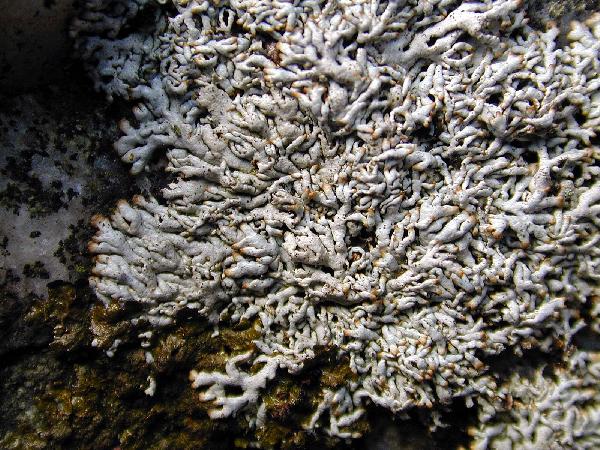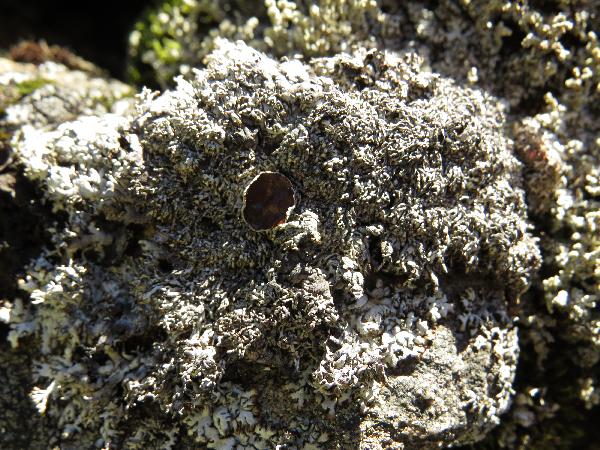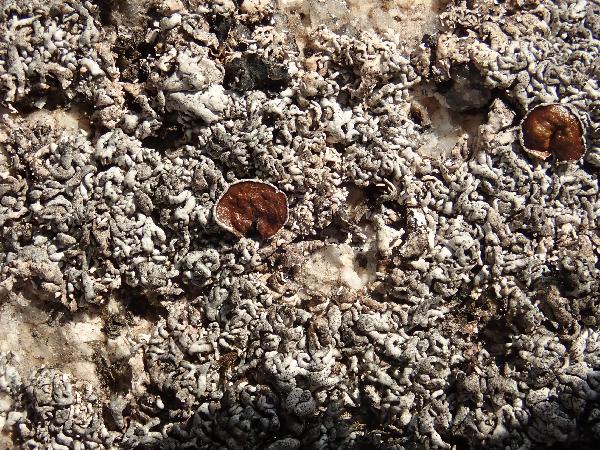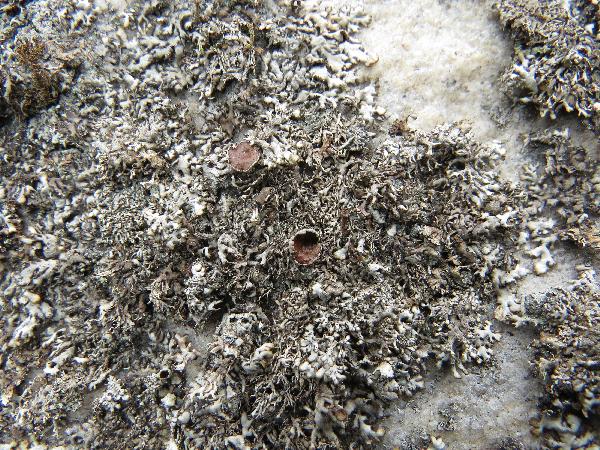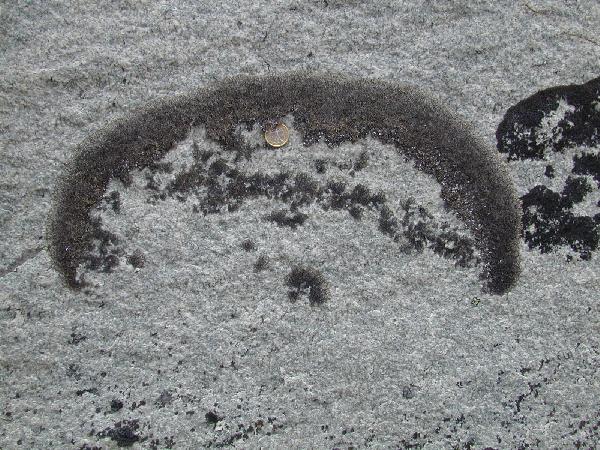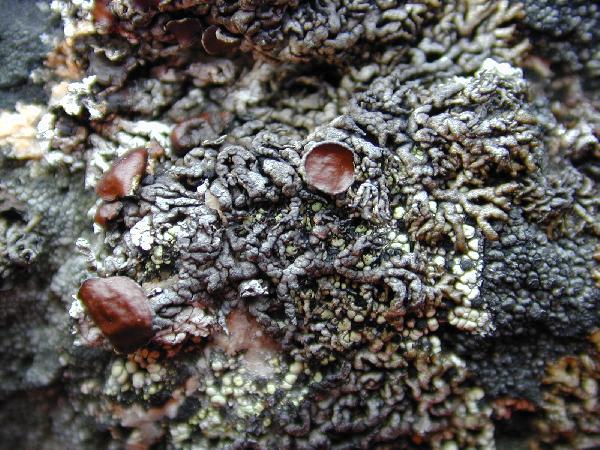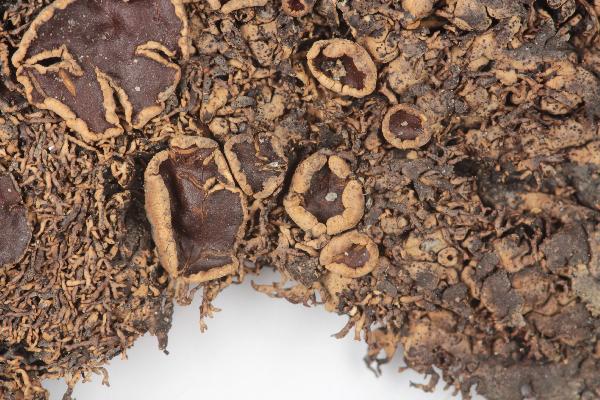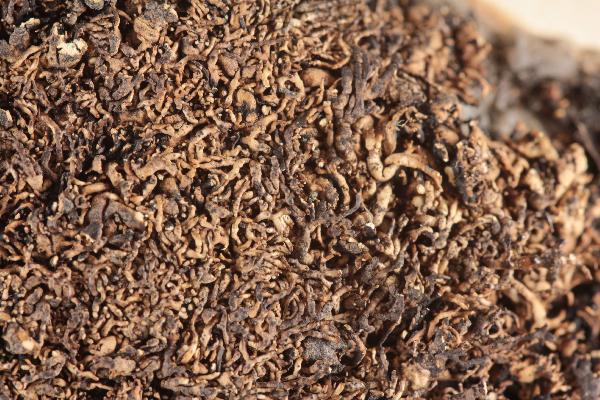Brodoa intestiniformis (Vill.) Goward
Bryologist, 89: 222, 1986. Basionym: Lichen intestiniformis Vill. - Hist. Pl. Dauphiné, 3: 947, 1789.
Synonyms: Hypogymnia encausta (Sm.) Walt. Watson; Hypogymnia intestiniformis (Vill.) Räsänen; Imbricaria encausta (Sm.) DC.; Menegazzia encausta (Sm.) Navàs; Parmelia ceratophylla var. multipuncta (Ehrh.) Schaer.; Parmelia encausta (Sm.) Nyl.; Parmelia encausta var. multipuncta (Ehrh.) Th. Fr.; Parmelia intestiniformis (Vill.) Ach.
Description: Thallus foliose, heteromerous, dorvisentral, adnate, forming 2-5 cm wide, orbicular or irregular rosettes. Lobes up to c. 2.5 cm long, 0.5-1(-2) mm broad, more or less convex, stiff, contiguous or overlapping; center of thallus with narrower (0.2-0.4 mm), flattened secondary lobules which arise perpendicularly to the surface. Upper surface pale grey to brownish, darkening or blackening especially on the lobules and towards the tips, and there becoming glossy, reticulate-maculate at least in the apical 2-3 mm. Lower surface black, brown toward the tips, smooth to weakly and shallowly wrinkled, erhizinate, with scattered hapters. Upper cortex paraplectenchymatous, the cell walls with Cetraria-type lichenan, with a non-pored epicortex; medulla white, solid; lower cortex paraplectenchymatous, without an epicortex. Apothecia rare, lecanorine, up to 5(-7) mm across, with a dark brown disc and a thin, entire to sublobulate thalline margin. Epithecium brownish; hypothecium and hymenium colourless. Asci 8-spored, clavate, the K/I+ blue tholus penetrated by a faintly amyloid apical cushion with parallel or diverging flanks, the wall K/I-, surrounded by a K/I+ blue outer layer, Lecanora-type. Ascospores 1-celled, hyaline, subglobose to broadly ellipsoid, 10-12 x 6-8 µm. Pycnidia numerous, immersed, the visible part black to grey-brown. Conidia bifusiform, 5-7 x c. 1 µm. Photobiont chlorococcoid. Spot tests: upper cortex K+ yellow, C-, KC-, P-; medulla K+ slowly reddish to orange-brown, C-, KC-, P+ orange, UV-. Chemistry: upper cortex with atranorin and chloroatranorin; medulla with fumarprotocetraric acid.
Growth form: Foliose, narrow lobed
Substrata: rocks
Photobiont: green algae other than Trentepohlia
Reproductive strategy: mainly sexual
Commonnes-rarity: (info)
Alpine belt: rather common
Subalpine belt: common
Montane belt: absent
Dry submediterranean belt: absent
Humid submediterranean belt: absent
Padanian area: absent
pH of the substrata:
1 2 3 4 5
Solar irradiation:
1 2 3 4 5
Aridity:
1 2 3 4 5
Eutrophication:
1 2 3 4 5
Poleotolerance:
0 1 2 3
Altitudinal distribution:
1 2 3 4 5 6
Rarity
absent
extremely rare
very rare
rare
rather rare
rather common
common
very common
extremely common
Loading data...
Occurrence data
Predictive map
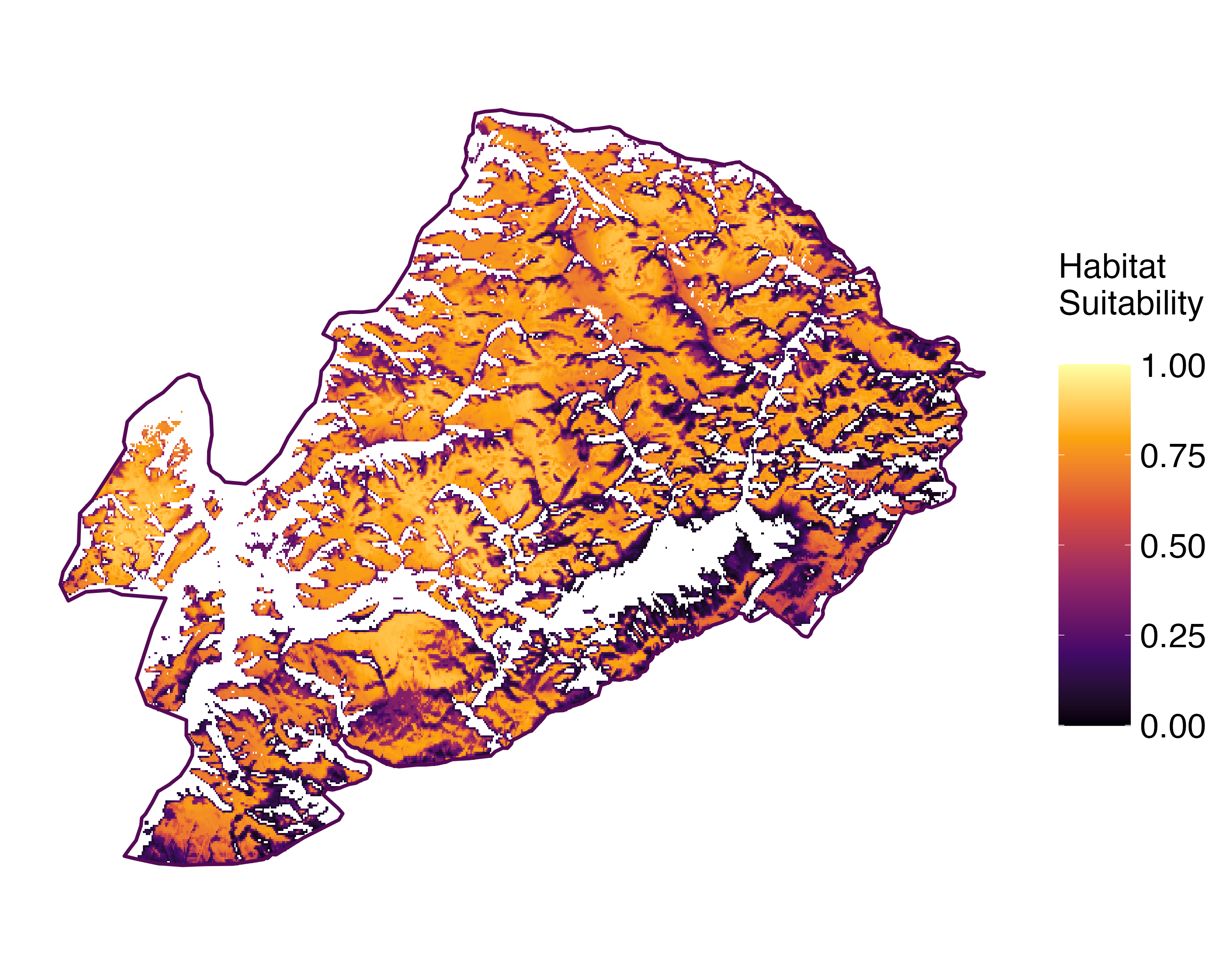 Current prediction (1981-2010)
Current prediction (1981-2010) Future prediction (2071-2100) SSP 1-2.6
Future prediction (2071-2100) SSP 1-2.6 Future prediction (2071-2100) SSP 5-8.5Predictive maps according to Francesconi et al. 2025
Future prediction (2071-2100) SSP 5-8.5Predictive maps according to Francesconi et al. 2025
P.L. Nimis; Owner: Department of Life Sciences, University of Trieste
Herbarium: TSB (12970)
2001/11/22
central lobuli

P.L. Nimis; Owner: Department of Life Sciences, University of Trieste
Herbarium: TSB (35222)
2002/07/12
central lobules

P.L. Nimis; Owner: Department of Life Sciences, University of Trieste
Herbarium: TSB (12970)
2001/11/22
detail of marginal lobes

Courtesy: Olivier et Danièle Gonnet - Source: https://www.afl-lichenologie.fr/Photos_AFL/Photos_AFL_B/Brodoa_intestiniformis.htm
France, Mont Cenis - 2081 m - Savoie
4/8/2011

Courtesy: Olivier et Danièle Gonnet - Source: https://www.afl-lichenologie.fr/Photos_AFL/Photos_AFL_B/Brodoa_intestiniformis.htm
France, Mont Cenis - 2081 m - Savoie
4/8/2011

Courtesy: Olivier et Danièle Gonnet - Source: https://www.afl-lichenologie.fr/Photos_AFL/Photos_AFL_B/Brodoa_intestiniformis.htm
France, Mont Cenis - 2081 m - Savoie
4/8/2011

Ulrich Kirschbaum CC BY-SA 4.0 - Source: https://www.thm.de/lse/ulrich-kirschbaum/flechtenbilder
On acid rocks.
Austria: Alps.
Growth form: Foliose, narrow lobed
Substrata: rocks
Photobiont: green algae other than Trentepohlia
Reproductive strategy: mainly sexual
Commonnes-rarity: (info)
Alpine belt: rather common
Subalpine belt: common
Montane belt: absent
Dry submediterranean belt: absent
Humid submediterranean belt: absent
Padanian area: absent
pH of the substrata:
| 1 | 2 | 3 | 4 | 5 |
Solar irradiation:
| 1 | 2 | 3 | 4 | 5 |
Aridity:
| 1 | 2 | 3 | 4 | 5 |
Eutrophication:
| 1 | 2 | 3 | 4 | 5 |
Poleotolerance:
| 0 | 1 | 2 | 3 |
Altitudinal distribution:
| 1 | 2 | 3 | 4 | 5 | 6 |
Rarity
absent
extremely rare
very rare
rare
rather rare
rather common
common
very common
extremely common
Loading data...
Occurrence data
Predictive map
 Current prediction (1981-2010)
Current prediction (1981-2010) Future prediction (2071-2100) SSP 1-2.6
Future prediction (2071-2100) SSP 1-2.6 Future prediction (2071-2100) SSP 5-8.5
Future prediction (2071-2100) SSP 5-8.5Predictive maps according to Francesconi et al. 2025

P.L. Nimis; Owner: Department of Life Sciences, University of Trieste
Herbarium: TSB (12970)
2001/11/22
central lobuli

P.L. Nimis; Owner: Department of Life Sciences, University of Trieste
Herbarium: TSB (35222)
2002/07/12
central lobules

P.L. Nimis; Owner: Department of Life Sciences, University of Trieste
Herbarium: TSB (12970)
2001/11/22
detail of marginal lobes

Courtesy: Olivier et Danièle Gonnet - Source: https://www.afl-lichenologie.fr/Photos_AFL/Photos_AFL_B/Brodoa_intestiniformis.htm
France, Mont Cenis - 2081 m - Savoie
4/8/2011

Courtesy: Olivier et Danièle Gonnet - Source: https://www.afl-lichenologie.fr/Photos_AFL/Photos_AFL_B/Brodoa_intestiniformis.htm
France, Mont Cenis - 2081 m - Savoie
4/8/2011

Courtesy: Olivier et Danièle Gonnet - Source: https://www.afl-lichenologie.fr/Photos_AFL/Photos_AFL_B/Brodoa_intestiniformis.htm
France, Mont Cenis - 2081 m - Savoie
4/8/2011



















